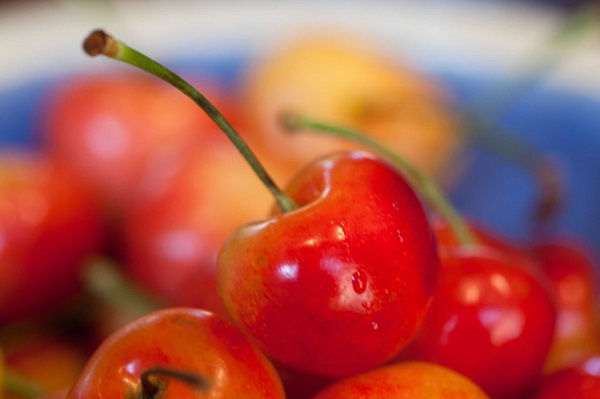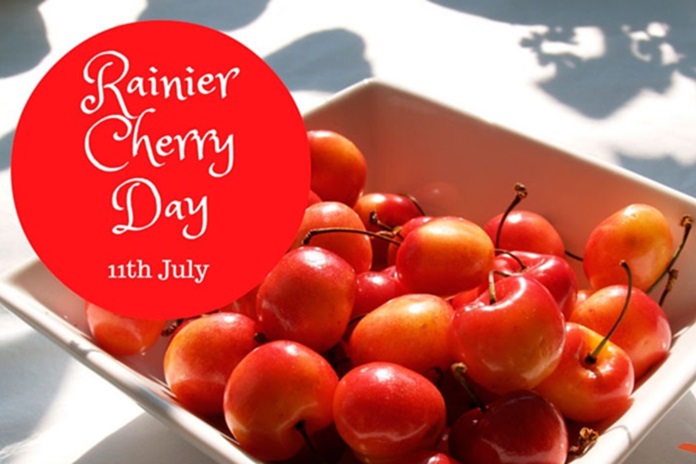National Rainier Cherry Day is celebrated in the United States on July 11. This day honors one of America’s Favorite summer fruits. It also marks the peak harvest time for Rainier cherries in Washington, which produces many of these cherries. Rainier cherries are yellow with a red blush, have soft yellow flesh, and a small brown seed. They are very sweet and considered high-quality fruits. These cherries are also rich in vitamins, minerals, and potassium.
History of National Rainier Cherry Day
The origin and creator of National Rainier Cherry Day are mostly unknown. In 1952, Dr. Harold W. Fogle, a researcher at Washington State University, crossed Bing and Van cherries to develop the unique Rainier cherry. The cherry is named after Mount Rainier in Washington State. Farmers began harvesting Rainier cherries for commercial production in 1960.
Rainier cherries are part of the Prunus genus and come from the wild cherry, Prunus avium. The best time to harvest them in Washington is in July, and they grow for only two months each year. Growing these cherries is challenging for farmers because their thin, fragile skin bruises easily. They are carefully hand-picked and placed in small bags or lugs to avoid damage. These cherries are sensitive to weather changes like high temperatures, rain, or strong winds.

Birds also love Rainier cherries and cause problems for farmers, who put up nets to protect the valuable fruit. The cherries are handled very carefully, even after being picked. Right after harvest, they are hydro-cooled to keep them fresh. Rainier cherries are more expensive than red cherries, but people are willing to pay extra for their sweetness and nutritional benefits.
| 1600s (Cherries Arrive in America) | Settlers from Europe bring cherries to America. |
| 1800s (Cherry Production Begins) | Modern-day cherry production starts in Michigan. |
| 1890s (Marasca Cherries) | Marasca cherries start appearing in the desserts of the country’s finest restaurants. |
| 1952 (Rainier Cherries) | Rainier cherries are created at Washington State University. |
Growing and Harvesting Rainier Cherries
Rainier cherries thrive in the temperate climate of the Pacific Northwest, where the combination of mild temperatures and ample rainfall creates ideal growing conditions. Washington State, Oregon, and parts of California are known for their Rainier cherry orchards.
The cherry trees bloom in early spring and are usually harvested in late June to early July. The short harvest window, combined with the delicate nature of Rainier cherries, makes them a seasonal treat that is eagerly anticipated each year.
Farmers and orchardists carefully monitor the ripeness of the cherries, as they need to be picked at just the right time to ensure optimal sweetness and flavor. The cherries are often harvested by hand to avoid damaging the delicate fruit.
Four Interesting Facts About Cherries
- Rainier cherries are sweeter and larger than red cherries.
- An average cherry tree can produce up to 7,000 cherries.
- King Charles V of France planted about 1,000 cherry trees in his garden.
- Cherries are believed to have originated in the region between the Caspian Sea and the Black Sea.
Health Benefits of Rainier Cherries
In addition to their delightful taste, Rainier cherries offer several health benefits:
Rich in Antioxidants: Rainier cherries are high in antioxidants, including vitamins A and C, which help protect the body from oxidative stress and inflammation.
Anti-Inflammatory Properties: The compounds in Rainier cherries may help reduce inflammation, which can be beneficial for overall health and for managing conditions like arthritis.
Support for Heart Health: The potassium content in Rainier cherries supports heart health by helping to regulate blood pressure and reduce the risk of cardiovascular disease.
Digestive Health: The fiber in Rainier cherries promotes healthy digestion and can aid in preventing constipation.
Conclusion
National Rainier Cherry Day, celebrated on July 11, highlights the exceptional Rainier cherry—a beloved summer fruit renowned for its sweet flavor and nutritional benefits. Developed in 1952 by Dr. Harold W. Fogle at Washington State University, the Rainier cherry is named after Mount Rainier and stands out for its yellow-red hue, delicate skin, and rich taste.
As the peak harvest period approaches in July, the careful cultivation and harvesting of these cherries become a labor of love, reflecting their high quality and the challenges faced by farmers. Beyond their delectable taste, Rainier cherries offer a range of health benefits, from antioxidants and anti-inflammatory properties to support for heart and digestive health. This day serves as a reminder to savor and appreciate this unique fruit and the efforts that go into bringing it to our tables each summer.
Frequently Asked Question
Are Rainier cherries in season?
Rainier cherries are in season from May to June in California and from June to August in Washington.
Why Rainier cherries are expensive?
Rainier cherries are expensive because they bruise easily and are more likely to be damaged by wind and rain. Additionally, the supply of Rainier cherries is much smaller compared to traditional dark red cherries.
Why are they called Rainier cherries?
As they are named after Mount Rainier, they are called Rainier cherries.
You may also like to read, National Piña Colada Day – July 10, 2024
